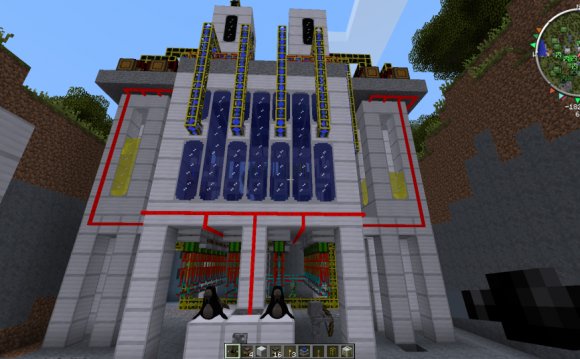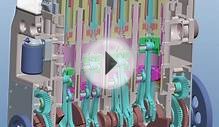
Pull up your modern sedan alongside a Model T Ford and the two will hardly seem related. Yes, there are still four wheels and a steering wheel, but that is where similarities seem to end.
Modern cars, are large, sleek and aerodynamic; made of advanced lightweight materials and feature a host of safety features. The Model T by comparison had no seat belts, air bags or anti-lock brakes, sat high off the ground and was made of steel, wood and even horse hair.
But open the bonnet – or hood, if you prefer – and there is a strange anachronism. The engines of both cars will likely still consist of very similar technology with four pistons moving up and down in four cylinders.
And what is more, the fuel efficiency of those engines has hardly altered. That first mass-produced car had an inline four cylinder engine, which produced 20hp (15kw) with a claimed fuel economy of 13-21 miles per gallon (mpg). Your sedan will likely have a modern four-cylinder engine that likely produces more like 200hp, but only with a slightly improved fuel economy of somewhere in the range of 20-30mpg.
But all that could soon change. The United States has just announced new regulations, which will require car makers to produce vehicles which go further, on less fuel. “We’ve set an aggressive target and the companies are stepping up to the plate, ” said President Obama in a statement. “By 2025, the average fuel economy of their vehicles will nearly double to almost 55 miles per gallon.”
Of course, in European countries where smaller cars and diesel engines are commonplace, these kinds of targets don’t seem that aggressive. But for the US, where emission laws prevent some of the technologies already used elsewhere being used, they are ambitious. And, what is more, they are likely to spur a new era of engine design that will not only replace the old fashioned four stroke, but could also change how engines work in the US and elsewhere.
Wasted work
Almost all engines today work on the principle that if you put a small amount of fuel, like petrol, in a small, enclosed space and ignite it, it explodes with a huge amount of energy. This can then harnessed, via a connecting rod and crankshaft, to drive the wheels.
Most engines do this several times a second using what is known as the four-stroke cycle. In this, an engines pistons rise and fall within its cylinder four times – known as the intake, compression, power, and exhaust strokes. In a modern, direct-fuel injected engine air is drawn in as the piston falls in the cylinder, then compressed as the piston pushes back up. Almost immediately fuel is injected and ignited, forcing the piston back down again in what is known as the power stroke. The final stroke of the piston expels the combustion products.
To ensure that there is continuous power, most cars have a series of cylinders – commonly four – allowing the pistons to be at different points in the cycle. Six or eight cylinder engines work on the same principle. Between them, these engines power almost all cars, boats, trucks, propeller aircraft, generators, and so on.
There are variants of these designs, which could help the US meet its targets. For example, hybrid vehicles which use a combination of electric motors and petrol engines already achieve fuel efficiency of close to 50mpg. In addition, manufacturers like Ford and Fiat, have introduced engines with fewer cylinders from the usual minimum of four; three in the case of Ford and two for Fiat. Both use turbochargers and clever timing-control to burn less fuel whilst maintaining the same power as other engines. Ford’s engines will be introduced to US cars next year.
But in order to push fuel efficiency figures higher, some designers are asking if we need a radical re-design of engines altogether.
Scuderi is developing an engine that still has pistons rising and falling in cylinders, but with one major difference. “What we do is we separate the four strokes, ” says Wrinn. In one cylinder, we have 2 strokes that deal with compression, and then in the other cylinder we have 2 strokes that deal with exhaust.”
What that practically means is that air is drawn into the compression cylinder as the piston moves down Rather than squirting fuel into this chamber, the compressed air is passed through a tube to a separate cylinder where fuel is injected and ignited to provide the power. A four cylinder engine working on this design would have two compression cylinders and two combustion cylinders.
“Because we can separate those two functions, we are able to maximize the compression process, and also maximize the combustion process, to make it a more efficient, cleaner combustion process” says Wrinn. In certain applications, Scuderi believes that this seemingly simple tweak can improve fuel efficiency by 40% or more.
At first glance, it looks like the Scuderi engine would have to have twice as many cylinders to make the same output, but that is not the case. It has a “power” stroke for every revolution of the engine, rather than every two.
‘Unexotic’
The innovative design allows for some other clever ideas. Compression and combustion do not have to happen in sequence, and Scuderi are working on what it calls an “air-hybrid” system. Instead of electric generators storing energy in batteries, as happens in today’s hybrids, the engine can disable the combustion cylinder when a vehicle is coasting, and re-route the air from the compression cylinder into a storage tank. The highly compressed air can be released later to power the engine without any fuel.
Other radical engine redesigns have been proposed over the last century, but the automotive industry has been slow to move, partly because it has never had to. The internal combustion engine as we know it has been tweaked and improved, and has proven to be highly reliable, very safe and ultimately cheap to make.
“There are a lot of great engine ideas and concepts out there, but the reality is that with the industry as it is, and the economy that we have, it is a lot easier to go in smaller incremental steps. That is more conducive to the current assembly and production lines, ” says Wrinn.
But Scuderi believes that its engine might be the one to finally knock the conventional four stroke off its pedestal. As well as improved efficiency, its basic architecture of cylinders and pistons is also very similar to a conventional engine.
“We are looking at around 95% or 96% of the same parts. We don’t have a lot of exotic materials, ” says Wrinn.
The firm is now talking with manufacturers all over the world, but the engine is likely to make a first appearance in Asia. The company believes that car makers in countries like China are more willing to experiment. Once it is licensed, it will be around three to five years before we see a Scuderi powered vehicle on the roads, which will be just in time to help meet those new US efficiency standards.
RELATED VIDEO












